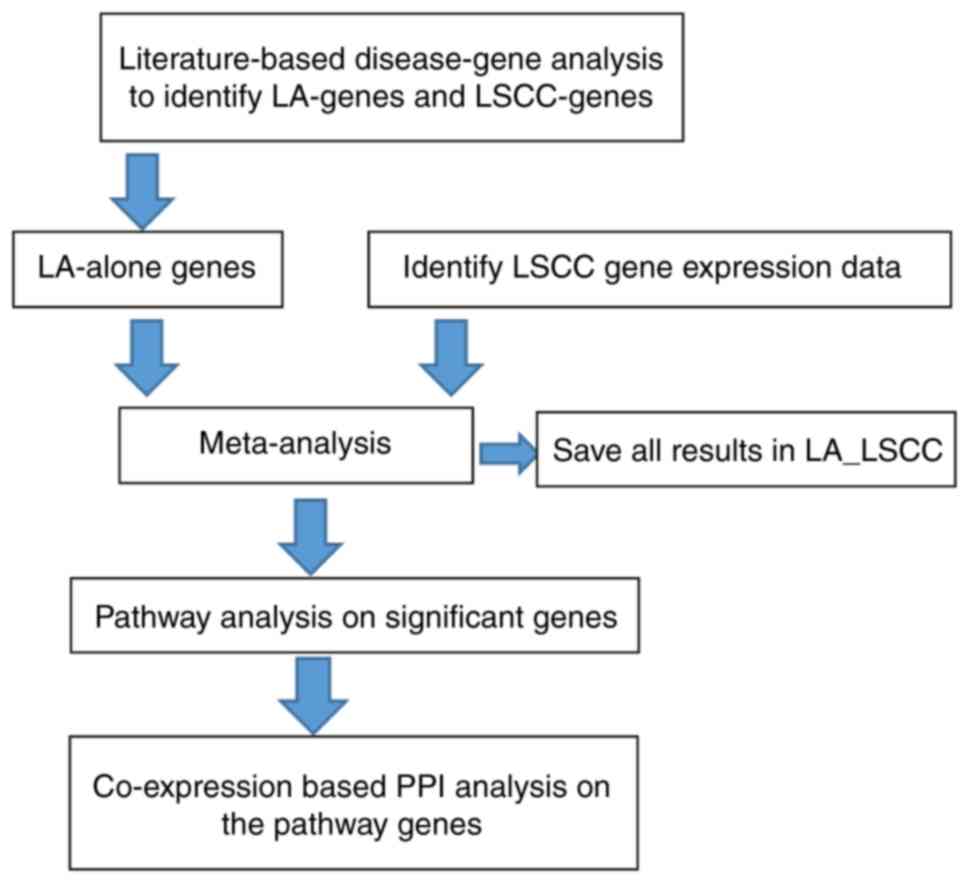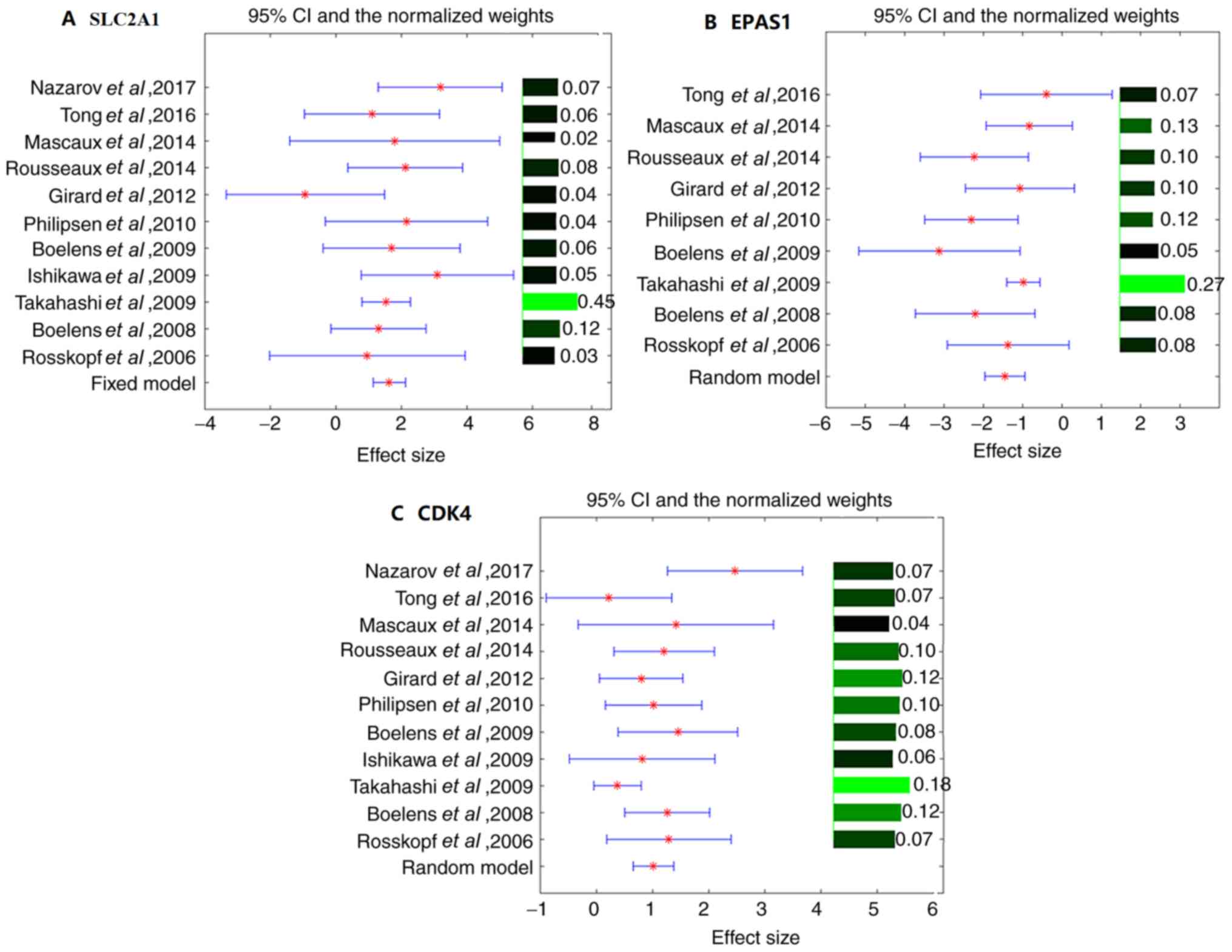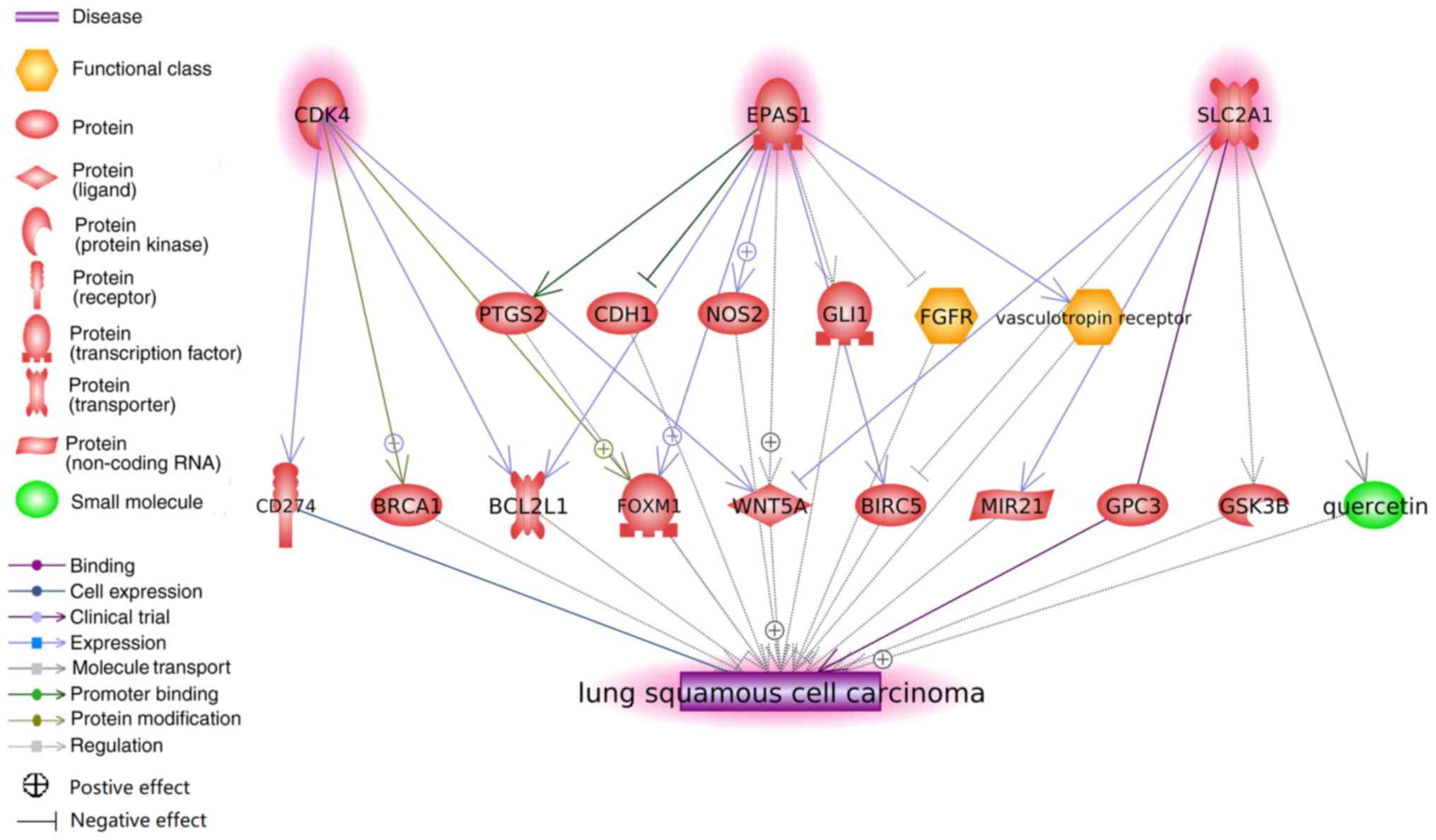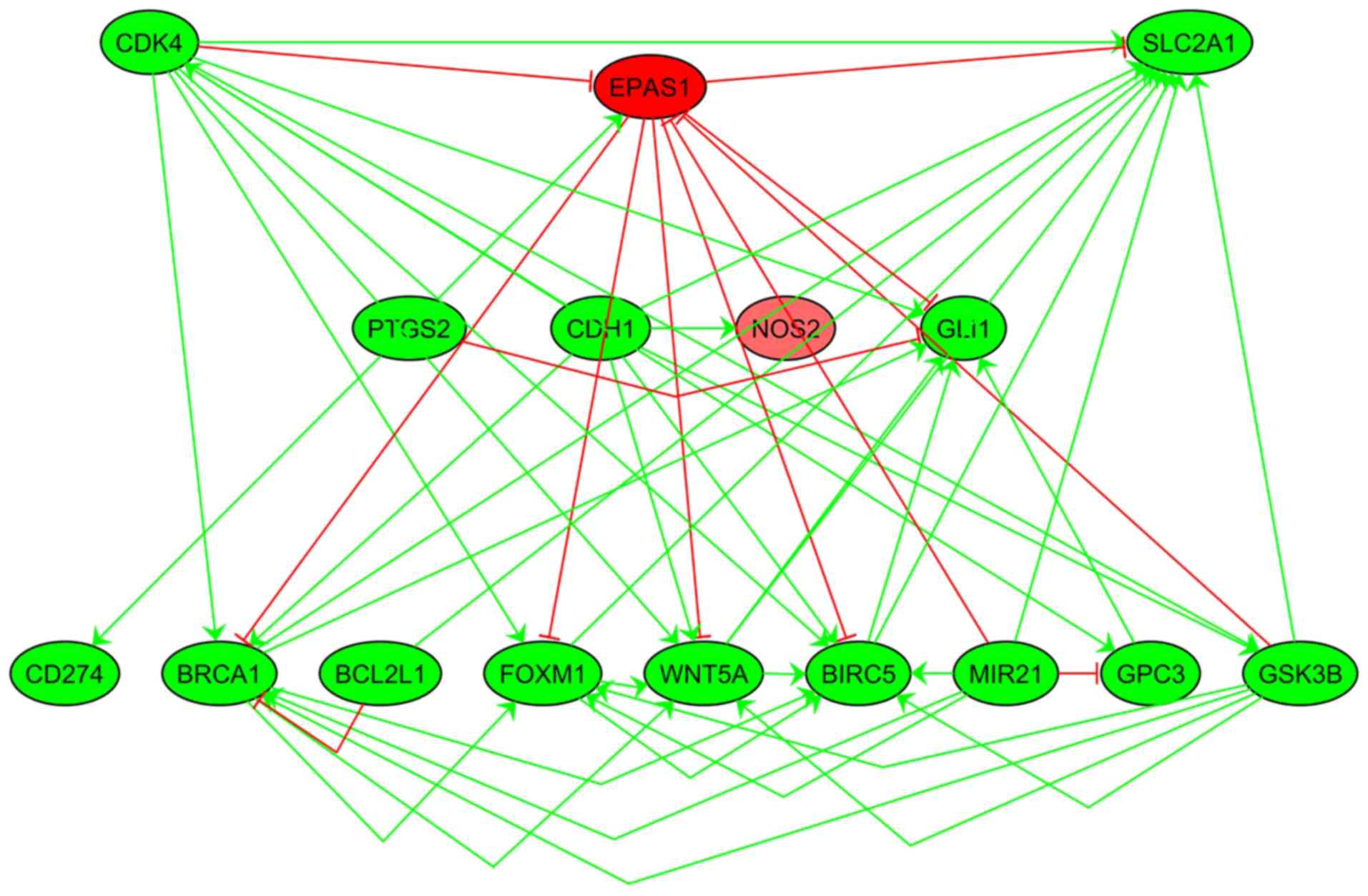|
1
|
Ansari J, Shackelford RE and El-Osta H:
Epigenetics in non-small cell lung cancer: From basics to
therapeutics. Transl Lung Cancer Res. 5:155–171. 2016. View Article : Google Scholar : PubMed/NCBI
|
|
2
|
Catacchio I, Scattone A, Silvestris N and
Mangia A: Immune prophets of lung cancer. The prognostic and
predictive landscape of cellular and molecular immune markers
Transl Oncol. 11:825–835. 2018.PubMed/NCBI
|
|
3
|
Chalela R, Curull V, Enríquez C, Pijuan L,
Bellosillo B and Gea J: Lung adenocarcinoma: From molecular basis
to genome-guided therapy and immunotherapy. J Thorac Dis.
9:2142–2158. 2017. View Article : Google Scholar : PubMed/NCBI
|
|
4
|
Cancer Genome Atlas Research Network, .
Comprehensive genomic characterization of squamous cell lung
cancers. Nature. 489:519–525. 2012. View Article : Google Scholar : PubMed/NCBI
|
|
5
|
Hirsch FR, Spreafico A, Novello S, Wood
MD, Simms L and Papotti M: The prognostic and predictive role of
histology in advanced non-small cell lung cancer: A literature
review. J Thorac Oncol. 3:1468–1481. 2008. View Article : Google Scholar : PubMed/NCBI
|
|
6
|
Pankratz VS, Sun Z, Aakre J, Li Y, Johnson
C, Garces YI, Aubry MC, Molina JR, Wigle DA and Yang P: Systematic
evaluation of genetic variants in three biological pathways on
patient survival in low stage non-small cell lung cancer. J Thorac
Oncol. 6:1488–1495. 2011. View Article : Google Scholar : PubMed/NCBI
|
|
7
|
Yandell M, Huff C, Hu H, Singleton M,
Moore B, Xing J, Jorde LB and Reese MG: A probabilistic
disease-gene finder for personal genomes. Genome Res. 21:1529–1542.
2011. View Article : Google Scholar : PubMed/NCBI
|
|
8
|
Zhang Y, Shen F, Mojarad MR, Li D, Liu S,
Tao C, Yu Y and Liu H: Systematic identification of latent
disease-gene associations from PubMed articles. PLoS One.
13:e01915682018. View Article : Google Scholar : PubMed/NCBI
|
|
9
|
Ellinghaus D, Jostins L, Spain SL, Cortes
A, Bethune J, Han B, Park YR, Raychaudhuri S, Pouget JG, Hübenthal
M, et al: Analysis of five chronic inflammatory diseases identifies
27 new associations and highlights disease-specific patterns at
shared loci. Nature Genetics. 48:510–518. 2016. View Article : Google Scholar : PubMed/NCBI
|
|
10
|
Chen D, Che N, Le J and Pan QL: A
co-training based entity recognition approach for cross-disease
clinical documents. Con Comput Pract Exp. e45052018. View Article : Google Scholar
|
|
11
|
Nikitin A, Egorov S, Daraselia N and Mazo
I: Pathway studio-the analysis and navigation of molecular
networks. Bioinformatics. 19:2155–2157. 2003. View Article : Google Scholar : PubMed/NCBI
|
|
12
|
Daraselia N, Yuryev A, Egorov S,
Novichkova S, Nikitin A and Mazo I: Extracting human protein
interactions from MEDLINE using a full-sentence parser.
Bioinformatics. 20:604–611. 2004. View Article : Google Scholar : PubMed/NCBI
|
|
13
|
Lorenzi PL, Claerhout S, Mills GB and
Weinstein JN: ‘A curated census of autophagy-modulating proteins
and small molecules: Candidate targets for cancer therapy’.
Autophagy. 10:1316–1326. 2014. View Article : Google Scholar : PubMed/NCBI
|
|
14
|
Edgar R, Domrachev M and Lash AE: Gene
expression omnibus: NCBI gene expression and hybridization array
data repository. Nucleic Acids Res. 30:207–210. 2002. View Article : Google Scholar : PubMed/NCBI
|
|
15
|
Barrett T, Wilhite SE, Ledoux P,
Evangelista C, Kim IF, Tomashevsky M, Marshall KA, Phillippy KH,
Sherman PM, Holko M, et al: NCBI GEO: Archive for functional
genomics data sets-update. Nucleic Acids Res 41 (Database Issue).
D991–D995. 2013.
|
|
16
|
Kahn N, Meister M, Eberhardt R, Muley T,
Schnabel PA, Bender C, Johannes M, Keitel D, Sültmann H, Herth FJ,
et al: Early detection of lung cancer by molecular markers in
endobronchial epithelial-lining fluid. J Thorac Oncol. 7:1001–1008.
2012. View Article : Google Scholar : PubMed/NCBI
|
|
17
|
Nazarov PV, Muller A, Kaoma T, Nicot N,
Maximo C, Birembaut P, Tran NL, Dittmar G and Vallar L: RNA
sequencing and transcriptome arrays analyses show opposing results
for alternative splicing in patient derived samples. BMC Genomics.
18:4432017. View Article : Google Scholar : PubMed/NCBI
|
|
18
|
Rousseaux S, Debernardi A, Jacquiau B,
Vitte AL, Vesin A, Nagy-Mignotte H, Moro-Sibilot D, Brichon PY,
Lantuejoul S, Hainaut P, et al: Ectopic activation of germline and
placental genes identifies aggressive metastasis-prone lung
cancers. Sci Transl Med. 5:186ra662013. View Article : Google Scholar : PubMed/NCBI
|
|
19
|
Byers LA, Diao L, Wang J, Saintigny P,
Girard L, Peyton M, Shen L, Fan Y, Giri U, Tumula PK, et al: An
epithelial-mesenchymal transition gene signature predicts
resistance to EGFR and PI3K inhibitors and identifies Axl as a
therapeutic target for overcoming EGFR inhibitor resistance. Clin
Cancer Res. 19:279–290. 2013. View Article : Google Scholar : PubMed/NCBI
|
|
20
|
Schuster K, Venkateswaran N, Rabellino A,
Girard L, Peña-Llopis S and Scaglioni PP: Nullifying the CDKN2AB
locus promotes mutant K-ras lung tumorigenesis. Mol Cancer Res.
12:912–923. 2014. View Article : Google Scholar : PubMed/NCBI
|
|
21
|
Hou J, Aerts J, den Hamer B, van Ijcken W,
den Bakker M, Riegman P, van der Leest C, van der Spek P, Foekens
JA, Hoogsteden HC, et al: Gene expression-based classification of
non-small cell lung carcinomas and survival prediction. PLoS One.
5:e103122010. View Article : Google Scholar : PubMed/NCBI
|
|
22
|
Boelens MC, Gustafson AM, Postma DS, Kok
K, van der Vries G, van der Vlies P, Spira A, Lenburg ME, Geerlings
M, Sietsma H, et al: A chronic obstructive pulmonary disease
related signature in squamous cell lung cancer. Lung Cancer.
72:177–183. 2011. View Article : Google Scholar : PubMed/NCBI
|
|
23
|
Fujiwara T, Hiramatsu M, Isagawa T,
Ninomiya H, Inamura K, Ishikawa S, Ushijima M, Matsuura M, Jones
MH, Shimane M, et al: ASCL1-coexpression profiling but not single
gene expression profiling defines lung adenocarcinomas of
neuroendocrine nature with poor prognosis. Lung Cancer. 75:119–125.
2012. View Article : Google Scholar : PubMed/NCBI
|
|
24
|
Boelens MC, van den Berg A, Fehrmann RS,
Geerlings M, de Jong WK, te Meerman GJ, Sietsma H, Timens W, Postma
DS and Groen HJ: Current smoking-specific gene expression signature
in normal bronchial epithelium is enhanced in squamous cell lung
cancer. J Pathol. 218:182–191. 2009. View Article : Google Scholar : PubMed/NCBI
|
|
25
|
Rohrbeck A, Neukirchen J, Rosskopf M,
Pardillos GG, Geddert H, Schwalen A, Gabbert HE, von Haeseler A,
Pitschke G, Schott M, et al: Gene expression profiling for
molecular distinction and characterization of laser captured
primary lung cancers. J Transl Med. 6:692008. View Article : Google Scholar : PubMed/NCBI
|
|
26
|
Takeuchi T, Tomida S, Yatabe Y, Kosaka T,
Osada H, Yanagisawa K, Mitsudomi T and Takahashi T: Expression
profile-defined classification of lung adenocarcinoma shows close
relationship with underlying major genetic changes and
clinicopathologic behaviors. J Clin Oncol. 24:1679–1688. 2006.
View Article : Google Scholar : PubMed/NCBI
|
|
27
|
Matsuyama Y, Suzuki M, Arima C, Huang QM,
Tomida S, Takeuchi T, Sugiyama R, Itoh Y, Yatabe Y, Goto H and
Takahashi T: Proteasomal non-catalytic subunit PSMD2 as a potential
therapeutic target in association with various clinicopathologic
features in lung adenocarcinomas. Mol Carcinog. 50:301–309. 2011.
View Article : Google Scholar : PubMed/NCBI
|
|
28
|
Borenstein M, Hedges LV, Higgins JP and
Rothstein HR: A basic introduction to fixed-effect and
random-effects models for mega-analysis. Res Synth Methods.
1:97–111. 2010. View
Article : Google Scholar : PubMed/NCBI
|
|
29
|
Davila DG and Williams DE: The etiology of
lung cancer. Mayo Clin Proc. 68:170–182. 1993. View Article : Google Scholar : PubMed/NCBI
|
|
30
|
Williams MD and Sandler AB: The
epidemiology of lung cancer. Cancer Treat Res. 105:31–52. 2001.
View Article : Google Scholar : PubMed/NCBI
|
|
31
|
Lemjabbar-Alaoui H, Hassan OU, Yang YW and
Buchanan P: Lung cancer: Biology and treatment options. BBA-Reviews
on Cancer. 1856:189–210. 2015.PubMed/NCBI
|
|
32
|
Piro RM and Di Cunto F: Computational
approaches to disease-gene prediction: Rationale, classification
and successes. FEBS J. 279:678–696. 2012. View Article : Google Scholar : PubMed/NCBI
|
|
33
|
Opap K and Mulder N: Recent advances in
predicting gene-disease associations. F1000Res. 6:5782017.
View Article : Google Scholar : PubMed/NCBI
|
|
34
|
Doncheva NT, Kacprowski T and Albrecht M:
Recent approaches to the prioritization of candidate disease genes.
Wiley Interdiscip Rev Syst Biol Med. 4:429–442. 2012. View Article : Google Scholar : PubMed/NCBI
|
|
35
|
Lee TI and Young RA: Transcriptional
regulation and its misregulation in disease. Cell. 152:1237–1251.
2013. View Article : Google Scholar : PubMed/NCBI
|
|
36
|
Botling J, Edlund K, Lohr M, Hellwig B,
Holmberg L, Lambe M, Berglund A, Ekman S, Bergqvist M, Pontén F, et
al: Biomarker discovery in non-small cell lung cancer: Integrating
gene expression profiling, mega-analysis and tissue microarray
validation. Clin Cancer Res. 19:194–204. 2013. View Article : Google Scholar : PubMed/NCBI
|
|
37
|
Ramasamy A, Mondry A, Holmes CC and Altman
DG: Key issues in conducting a mega-analysis of gene expression
microarray datasets. PLoS Med. 5:e1842008. View Article : Google Scholar : PubMed/NCBI
|
|
38
|
El-Telbany A and Ma PC: Cancer genes in
lung cancer: Racial disparities: Are there any? Genes Cancer.
3:467–480. 2012. View Article : Google Scholar : PubMed/NCBI
|
|
39
|
Siegel R, Ward E, Brawley O and Jemal A:
Cancer statistics, 2011: The impact of eliminating socioeconomic
and racial disparities on premature cancer deaths. Ca Cancer J
Clin. 61:212–236. 2011. View Article : Google Scholar : PubMed/NCBI
|
|
40
|
Schabath MB, Cress D and Munoz-Antonia T:
Racial and ethnic differences in the epidemiology and genomics of
lung cancer. Cancer Control. 23:338–346. 2016. View Article : Google Scholar : PubMed/NCBI
|
|
41
|
Hardy D, Liu CC, Xia R, Cormier JN, Chan
W, White A, Burau K and Du XL: Racial disparities and treatment
trends in a large cohort of elderly black and white patients with
nonsmall cell lung cancer. Cancer. 115:2199–2211. 2009. View Article : Google Scholar : PubMed/NCBI
|
|
42
|
Wierstra I: CyclinD1/Cdk4 increases the
transcriptional activity of FOXM1c without phosphorylating FOXM1c.
Biochem Biophys Res Commun. 431:753–759. 2013. View Article : Google Scholar : PubMed/NCBI
|
|
43
|
Yang DK, Son CH, Lee SK, Choi PJ, Lee KE
and Roh MS: Forkhead box M1 expression in pulmonary squamous cell
carcinoma: Correlation with clinicopathologic features and its
prognostic significance. Hum Pathol. 40:464–470. 2009. View Article : Google Scholar : PubMed/NCBI
|
|
44
|
Zhang F, Chen X, Wei K, Liu D, Xu X, Zhang
X and Shi H: Identification of key transcription factors associated
with lung squamous cell carcinoma. Med Sci Monit. 23:172–206. 2017.
View Article : Google Scholar : PubMed/NCBI
|
|
45
|
Maru S, Ishigaki Y, Shinohara N, Takata T,
Tomosugi N and Nonomura K: Inhibition of mTORC2 but not mTORC1
up-regulates E-cadherin expression and inhibits cell motility by
blocking HIF-2α expression in human renal cell carcinoma. J Urol.
189:1921–1929. 2013. View Article : Google Scholar : PubMed/NCBI
|
|
46
|
Murugesan T, Rajajeyabalachandran G, Kumar
S, Nagaraju S and Jegatheesan SK: Targeting HIF-2α as therapy for
advanced cancers. Drug Discov Today. 23:1444–1451. 2018. View Article : Google Scholar : PubMed/NCBI
|
|
47
|
Pallier K, Cazes A, El Khattabi L, Lecchi
C, Desroches M, Danel C, Riquet M, Fabre-Guillevin E, Laurent-Puig
P and Blons H: DeltaN TP63 reactivation, epithelial phenotype
maintenance, and survival in lung squamous cell carcinoma. Tumor
Biol. 33:41–51. 2012. View Article : Google Scholar
|
|
48
|
Xiong J, Zhu FF and Nie MF:
Hypoxia-inducible factor-2α (HIF-2α) mediates the effects of
hypoxia on the promotion of HeLa cell viability, colony formation,
and invasion capacity in vitro. Genet Mol Res. 14:3281–3292. 2015.
View Article : Google Scholar : PubMed/NCBI
|
|
49
|
Cho HS, Ahn JM, Han HJ and Cho JY:
Glypican 3 binds to GLUT1 and decreases glucose transport activity
in hepatocellular carcinoma cells. J Cell Biochem. 111:1252–1292.
2010. View Article : Google Scholar : PubMed/NCBI
|
|
50
|
Cunningham P, Afzal-Ahmed I and Naftalin
RJ: Docking studies show that d-glucose and quercetin slide through
the transporter GLUT1. J Biol Chem. 281:5797–5803. 2006. View Article : Google Scholar : PubMed/NCBI
|
|
51
|
Li K, Pan X, Bi Y, Xu W, Chen C, Gao H,
Shi B, Jiang H, Yang S, Jiang L and Li Z: Adoptive immunotherapy
using T lymphocytes redirected to glypican-3 for the treatment of
lung squamous cell carcinoma. Oncotarget. 7:2496–2507.
2016.PubMed/NCBI
|
|
52
|
Yang JH, Hsia TC, Kuo HM, Chao PD, Chou
CC, Wei YH and Chung JG: Inhibition of lung cancer cell growth by
quercetin glucuronides via G2/M arrest and induction of apoptosis.
Drug Metab Dispos. 34:296–304. 2006. View Article : Google Scholar : PubMed/NCBI
|


















